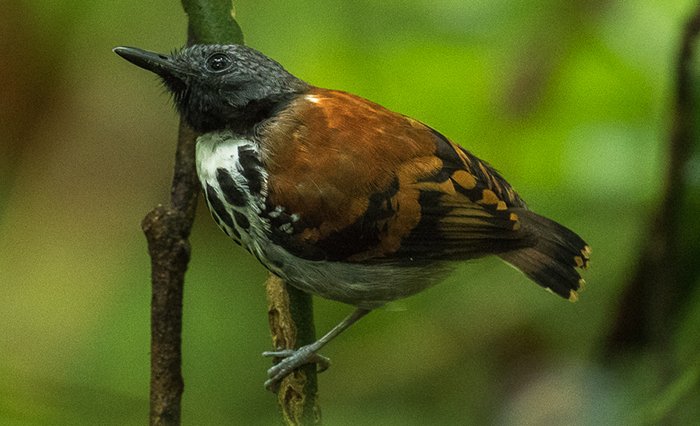This Bird Loves Ants!
Hector Bottai, CC BY-SA 4.0, via Wikimedia Commons
Thamnophilidae
by Inspector Barry Mins on August 9, 2022Hey kids, welcome back to our series on the mysteries of created kinds.
This week, we migrate to Central and South America, looking for a large family of small birds. These birds get their name from a behavior some of their members use to find food, which we will talk more about in just a moment.

This week’s kind is very diverse. It includes over two hundred species, so this article cannot address every one. Instead, I will attempt to cover some broad generalities about the kind.
Many species follow army ant swarms, eating the other insects that the mass of swarming ants root out in their travels.1 Some species depend entirely on the army ants to find their food for them, while for others, it’s simply a convenience. Much like we might stop for pizza or a burger if we are hungry and don’t want to cook, some of these birds use the army ants the same way. Some birds will literally follow the swarms around or, if they cannot find a swarm, will visit known ant colonies looking for one to follow.2
Males and females mate for life in most species, and males and females will respond to one another’s song.3 Both sexes forage for food together, but males tend to feed the young more than females do.4 Generally, the females lay one or two eggs,5 often splotchy pink in color.6 Nestlings hatch without feathers.7
Has anyone figured it out yet? You might have been able to figure out their name from their habit of following army ants. This week’s kind is the Thamnophilidae—the antbird kind. Next week, we go looking for a different type of bird. This one is found in the tropics worldwide.

Spotted Antbird
Francesco Veronesi from Italy, CC BY-SA 2.0, via Wikimedia Commons
Try out this fun crossword puzzle!
Clue
Here is your clue for next week:
This bird gets its name from its long, thin neck.
Ask a Question
Have you ever had a question about created kinds but didn’t know who to ask? Have you ever wanted to learn more about your favorite kind? Well, now you can! You can ask me, Inspector Barry Mins, a question! Have your parents help you fill out this form, and you might get your question answered in my column! If you have any questions about created kinds, feel free to send them my way!
Footnotes
- P. H. Wrege, M. Wikelski, J. T. Mandel, T. Rassweiler, and I. D. Couzin, “Antbirds parasitize foraging army ants,” Ecology 86, no. 3 (2005): 555–569.
- J. Chaves-Campos, “Ant colony tracking in the obligate army ant-following antbird Phaenosticus mcleannani,” Journal of Ornithology 152, (2011): 497–504.
- N. Seddon and J. A. Tobias, “Duets defend mates in a suboscine passerine, the warbling antbird (Hypocnemis cantator),” Behavioral Ecology 17, no. 1 (2006): 73–83.
- R. Greenberg and J. Gradwohl, “Sexual roles in the dot-winged antwren (Microrhopias quixensis) a tropical forest passerine,” The Auk 100 (1983): 920–925.
- A. M. X. de Lima and J. J. Roper, “A tropical bird with a short breeding season and high rates of nesting success: the breeding ecology of the Star-throated Antwren (Rhopias gularis: Thamnophilidae) in subtropical Brazil,” Emu 116, no. 4 (2016): 411–422.
- H. F. Greeney, C. Sanchez, J. E. Sanchez, and E. Carman, “A review of nest and egg descriptions for the genus Myrmeciza, with the first description of nests and eggs of the dull-mantled antbird (M. laemosticta),” Journal of Ornithology 154 (2013): 1049–1056.
- G. A. Londono, “First description of the nest and eggs of the plumbeous (Myrmeciza hyperythra) and the black-faced (Myrmoborus myotherinus) antbirds,” Ornitologia Neotropical 14 (2003): 405–410.
- © 2025 Answers in Genesis
- Privacy Policy
- Contact
- About
